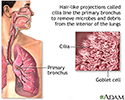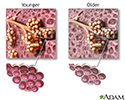Aging changes in the lungs
The lungs have two main functions. One is to get oxygen from the air into the body. The other is to remove carbon dioxide from the body. Your body needs oxygen to work properly. Carbon dioxide is a gas the body produces when it uses oxygen.
During breathing, air enters and exits the lungs. When you breathe in (inhale), air flows through the airways into the lungs. The airways are made of stretchy tissue. Bands of muscle and other support tissue wrap around each airway to help keep them open.
Air keeps flowing into the lungs until it fills tiny air sacs. Blood circulates around these air sacs through tiny blood vessels. Oxygen crosses into the bloodstream at the place where the blood vessels and air sacs meet. This is also where carbon dioxide crosses from the bloodstream into the lungs to be breathed out (exhaled).
AGING CHANGES IN YOUR BODY AND THEIR AFFECTS ON THE LUNGS
Changes to the bones and muscles of the chest and spine:
- Bones become thinner and change shape. This can change the shape of your ribcage. As a result, your ribcage cannot expand and contract as well during breathing.
- The muscle that supports your breathing, the diaphragm, becomes weakened. This weakness may prevent you from breathing enough air in or out.
These changes in your bones and muscles may lower the oxygen level in your body. Also, less carbon dioxide may be removed from your body. Symptoms such as tiredness and shortness of breath can result.
Changes to lung tissue:
- Muscles and other tissues that are near your airways may lose their ability to keep the airways completely open. This causes the airways to close easily.
- Aging also causes the air sacs to lose their shape and become baggy.
These changes in lung tissue can allow air to get trapped in your lungs. Too little oxygen may enter your blood vessels and less carbon dioxide may be removed. This makes it hard to breathe.
Changes to the nervous system:
- The part of the brain that controls breathing may lose some of its function. When this happens, your lungs are not able to get enough oxygen. Not enough carbon dioxide may leave the lungs. Breathing may get more difficult.
- Nerves in your airways that trigger coughing become less sensitive. Large amounts of particles like smoke or germs may collect in the lungs and may be hard to cough up.
Changes to the immune system:
- Your immune system can get weaker. This means your body is less able to fight lung infections and other diseases.
- Your lungs are also less able to recover after exposure to smoke or other harmful particles.
COMMON PROBLEMS
As a result of these changes, older people are at increased risk for:
-
Lung infections, such as
pneumonia
and
bronchitis
Pneumonia
Pneumonia is a breathing (respiratory) condition in which there is an infection of the lung. This article covers community-acquired pneumonia (CAP). ...
 ImageRead Article Now Book Mark Article
ImageRead Article Now Book Mark ArticleBronchitis
Acute bronchitis is swelling and inflamed tissue in the main passages that carry air to the lungs. This swelling narrows the airways, which makes it...
 ImageRead Article Now Book Mark Article
ImageRead Article Now Book Mark Article - Shortness of breath
- Low oxygen level
-
Abnormal breathing patterns, resulting in problems such as
sleep apnea
(episodes of stopped breathing during sleep)
Sleep apnea
Obstructive sleep apnea (OSA) is a problem in which your breathing pauses during sleep. This occurs because of narrowed or blocked airways.
 ImageRead Article Now Book Mark Article
ImageRead Article Now Book Mark Article
PREVENTION
To decrease the effects of aging on the lungs:
- DO NOT smoke. Smoking harms the lungs and speeds up lung aging.
- Do physical exercise to improve lung function.
- Get up and move. Lying in bed or sitting for long periods allows mucus to collect in the lungs. This puts you at risk of lung infections. This is especially true right after surgery or when you are ill.
OTHER CHANGES RELATED TO AGING
As you grow older, you will have other changes, including:
-
In organs, tissues, and cells
In organs, tissues, and cells
All vital organs begin to lose some function as you age during adulthood. Aging changes occur in all of the body's cells, tissues, and organs, and t...
 ImageRead Article Now Book Mark Article
ImageRead Article Now Book Mark Article -
In the bones, muscles, and joints
In the bones, muscles, and joints
Changes in posture and gait (walking pattern) are common with aging. Changes in the skin and hair are also common. The skeleton provides support and...
 ImageRead Article Now Book Mark Article
ImageRead Article Now Book Mark Article -
In the heart and blood vessels
In the heart and blood vessels
Some changes in the heart and blood vessels normally occur with age. However, many other changes that are common with aging are due to modifiable fa...
 ImageRead Article Now Book Mark Article
ImageRead Article Now Book Mark Article -
In vital signs
In vital signs
Vital signs include body temperature, heart rate (pulse), breathing rate, and blood pressure. As you age, your vital signs may change, depending on ...
 ImageRead Article Now Book Mark Article
ImageRead Article Now Book Mark Article
References
Amin P, Smith AM. Pulmonary disease. In: Ham RJ, Sloane PD, Warshaw GA, Potter JF, Flaherty E, eds. Ham's Primary Care Geriatrics: A Case-Based Approach . 6th ed. Philadelphia, PA: Elsevier Saunders; 2014:chap 48.
Cefalu CA. Theories and mechanisms of aging. Clinics Geriatr Med . 2011;27(4):491-506. PMID: 22062437 www.ncbi.nlm.nih.gov/pubmed/22062437 .
Davies GA, Bolton CE. Age-related changes in the respiratory system. In: Fillit HM, Rockwood K, Young J, eds. Brocklehurst's Textbook of Geriatric Medicine and Gerontology . 8th ed. Philadelphia, PA: Elsevier; 2017:chap 17.
Walston JD. Common clinical sequelae of aging. In: Goldman L, Schafer AI, eds. Goldman-Cecil Medicine . 25th ed. Philadelphia, PA: Elsevier Saunders; 2016:chap 25.
-
Respiratory cilia - illustration
The bronchus in the lungs are lined with hair-like projections called cilia that move microbes and debris up and out of the airways. Scattered throughout the cilia are goblet cells that secrete mucus which helps protect the lining of the bronchus and trap microorganisms.
Respiratory cilia
illustration
-
Changes in lung tissue with age - illustration
Lung tissue atrophies and is not as efficient with age.
Changes in lung tissue with age
illustration
-
Respiratory cilia - illustration
The bronchus in the lungs are lined with hair-like projections called cilia that move microbes and debris up and out of the airways. Scattered throughout the cilia are goblet cells that secrete mucus which helps protect the lining of the bronchus and trap microorganisms.
Respiratory cilia
illustration
-
Changes in lung tissue with age - illustration
Lung tissue atrophies and is not as efficient with age.
Changes in lung tissue with age
illustration
Review Date: 8/22/2016
Reviewed By: Laura J. Martin, MD, MPH, ABIM Board Certified in Internal Medicine and Hospice and Palliative Medicine, Atlanta, GA. Also reviewed by David Zieve, MD, MHA, Isla Ogilvie, PhD, and the A.D.A.M. Editorial team.


